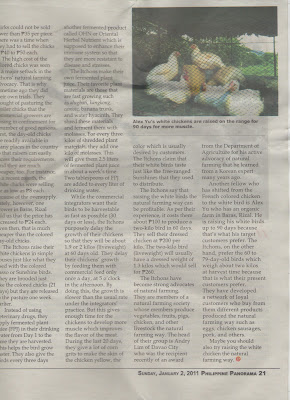We have always been on the look out for ways and means to make work load lighter for our workers. The recipe for making Fermented Plant Juice (FPJ) seems easy of you will read it at 2kgs plants and 1k Molasses. With that, you will harvest about 2.5liters of FPJ. That amount is OK if you have a backyard of vegetables to tend and spray. But if you are doing commercial farming of pastured chickens, we ferment about 20kgs of plants almost every other day.
Preparing for an instructional video on making the different concoctions, made me see how our staff is making FPJ, OHN etc on a close up view.
I took photographs recently on a very sad moment and after that I told Doc Rey that it pays to get a professional photographer in times of grief. I experienced and saw the sadness of everyone as you frame them in your camera's lens and create a subject.
To cut on time, we had gotten a shredder/chopper for the preparation of the materials for FPJ. But now that I was taking photos and video for the movie we will make, I saw how difficult it was to harvest and press the sludge to extract the FPJ, OHN etc, manually. The OHN was very hot to the touch...imagine all that garlic, onions, ginger, chili etc. Doc Rey commented on it too, and he was just seeing the photos and the raw videos. He wasn't present during the harvest.
You just have to ask others, as surely, they have encountered the same problems. How do we extract and press the sludge, aside from manually? One said go to a machine shop and have a presser made. One said they used an old washing machine that only the spinner is left working. Bright idea!
I told my staff right away and she said she had thought about that too and that she thought of using the plastic net bags to portion them well so not to heavy load for the spinner and no mess as the sludge will be in the net bags. Yes, just as Jojie said...spinner and net bags :)
Doc Rey keeps old things well...after I called him, he came back with an old , working washing machine. They set it up high so it will be easy to harvest and drain from the hose.
Ask...don't be shy! Natural farmers are very generous with time, effort and knowledge :)










